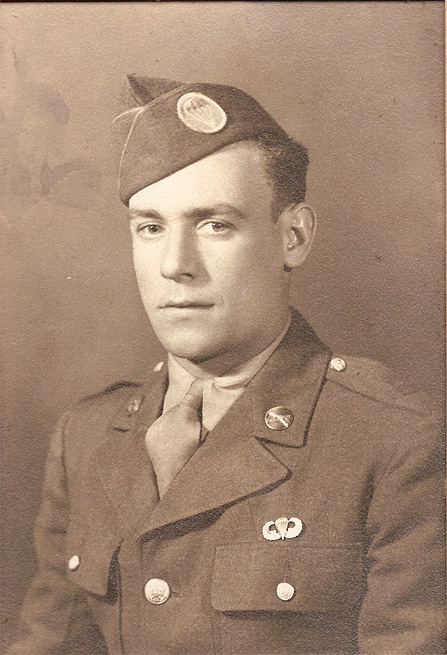
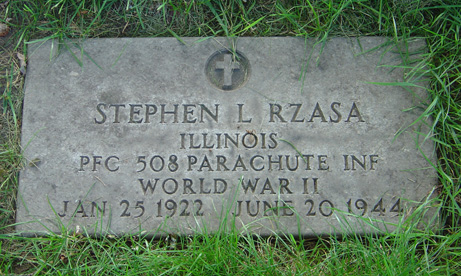
Steven Rzasa
Killed in Normandy on 20 June 1944
This page is dedicated to my great-uncle Steven Rzasa (1922-1944)
Click on the images to download full sized copies.
Thanks to the Kowalke family for these images.
|
|
The family story told to us by my mother was that Steven was shot and killed on D-Day and was dead before he hit the ground. His tombstone says he died on June 20th. At my aunt's funeral a few years ago, a distant cousin said that Steven was shot on the drop but was patched up and sent back into battle and was killed on the 20th. I recently obtained these documents from my cousins the Kowalkes and these documents confirm that this is what happen. |
 |
Steven Rzasa's tombstone in Holy Cross Cemetery in Calumet City Illinois. |
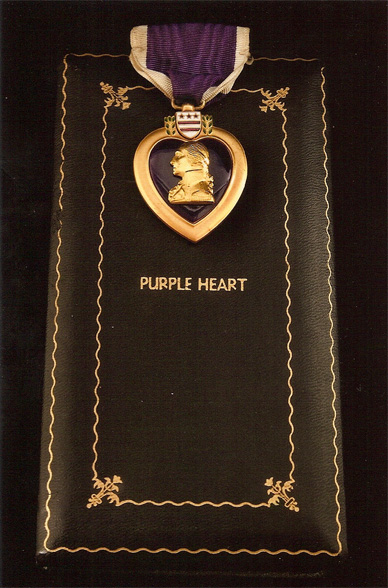 |
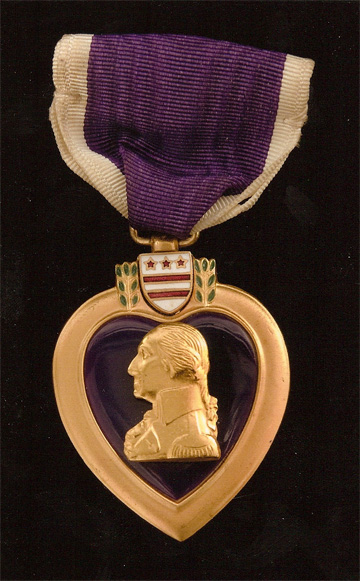 |
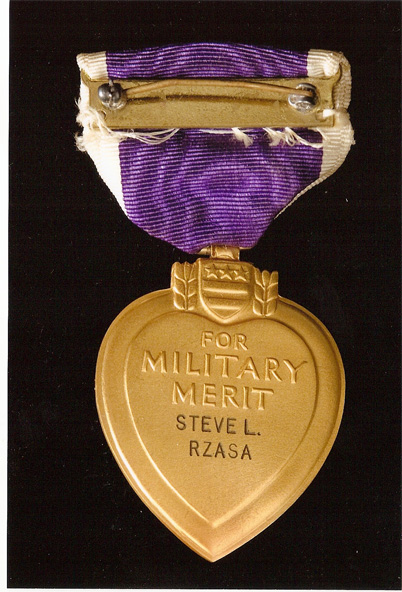 |
Steven Rzasa's posthumous Purple Heart Medal
In 1938 and 1939, Steven Rzasa spent time in the Civilian Conservation Corps.
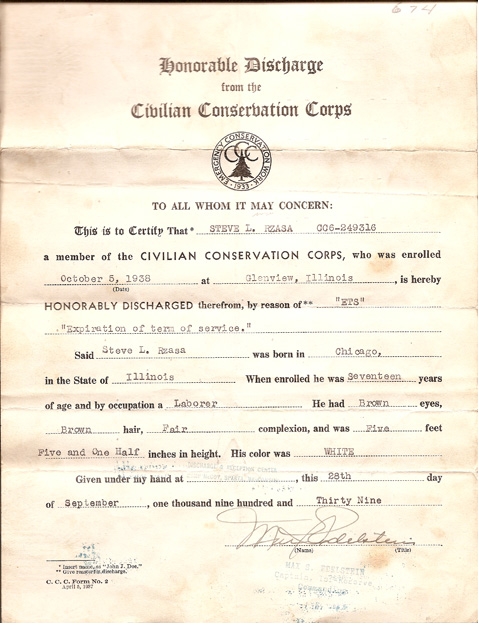 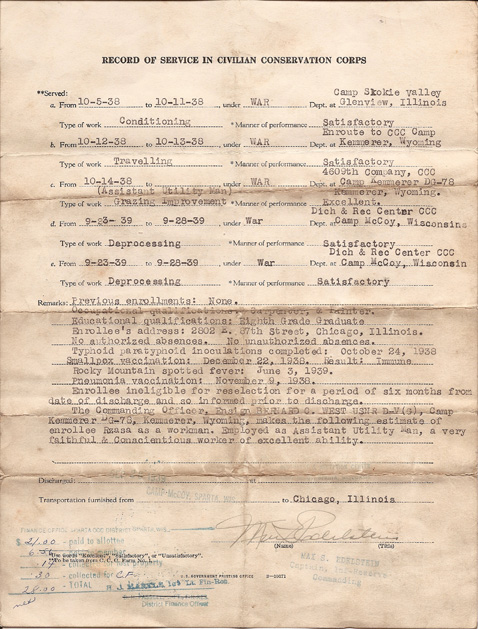 |
|
| These photos were in Sparta, near Fort McCoy, Wisconsin so they are probably dated 1939, when Steven was out processing. |
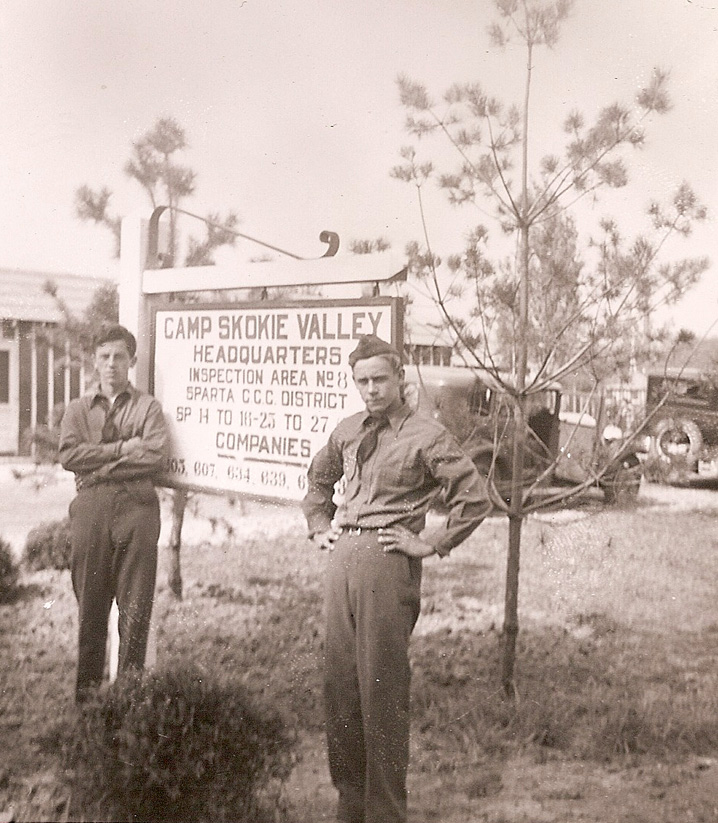 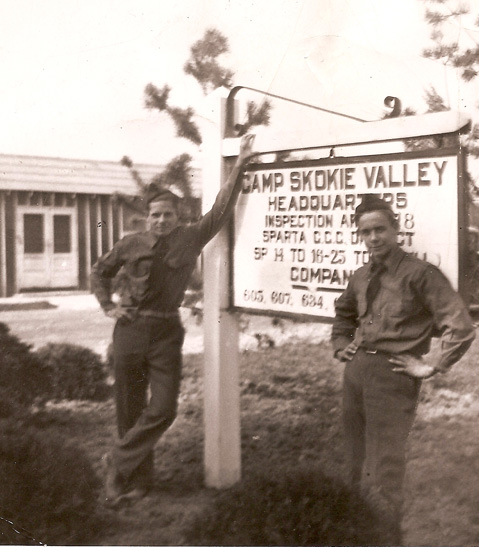 |
|
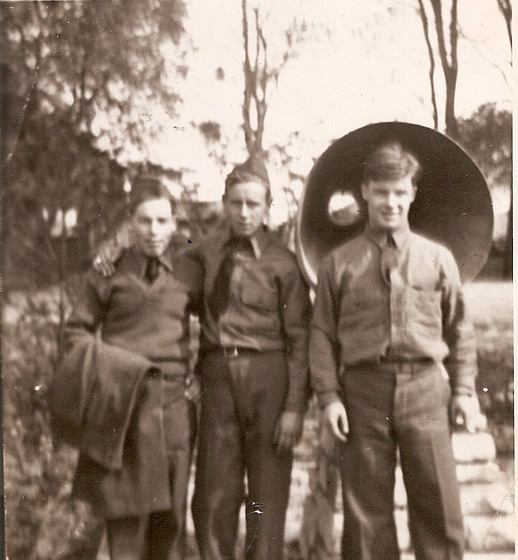 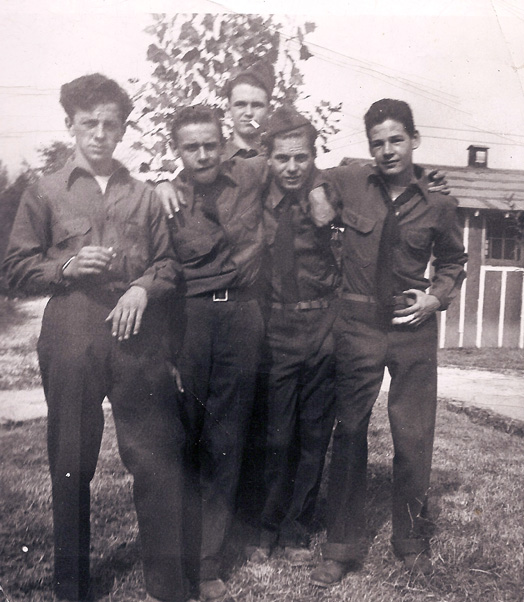 |
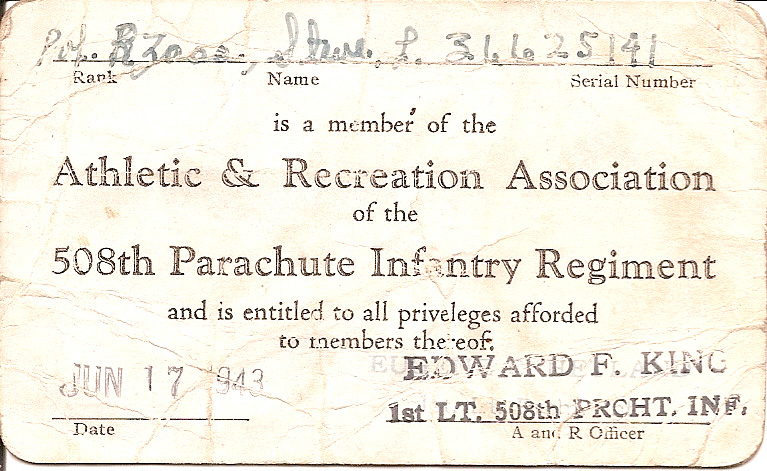
Steven was granted a furlough in 1943 before shipping off for the war.
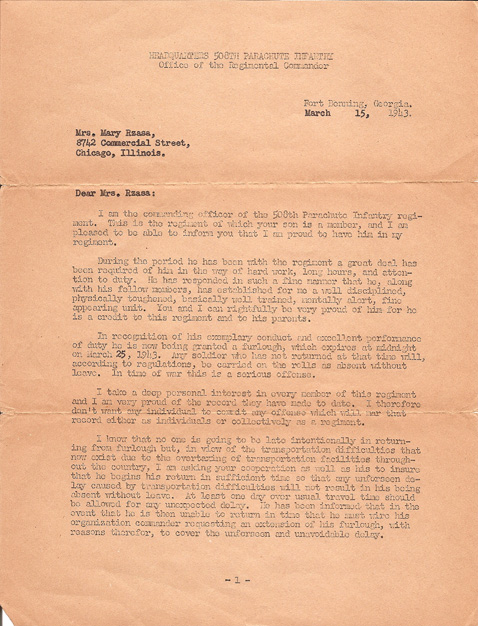 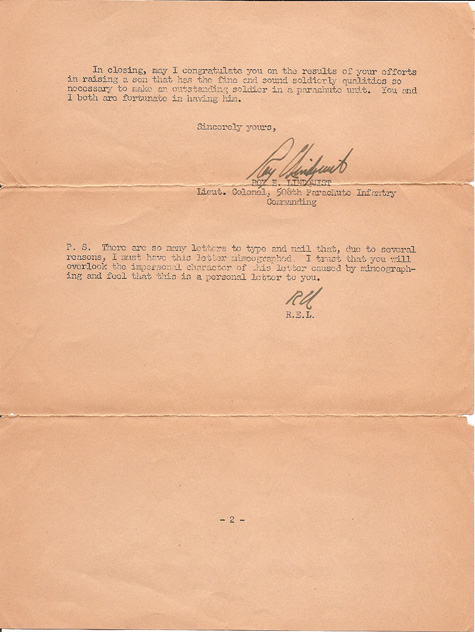 |
On 16 November, 1943, PVT Steven L. Rzasa from HQ3 was awarded the Good Conduct Medal at Camp MacKall, NC under GO-58
The 508 Parachute Infantry Regiment had an Organizational Day on Nov 4th, 1944. Click here to download a PDF of this book.
HQ&HHC, 3rd Battalion, 508 Parachute Infantry Regiment. Steven Rzasa is in the 9th row of enlisted men, 6th from the left.
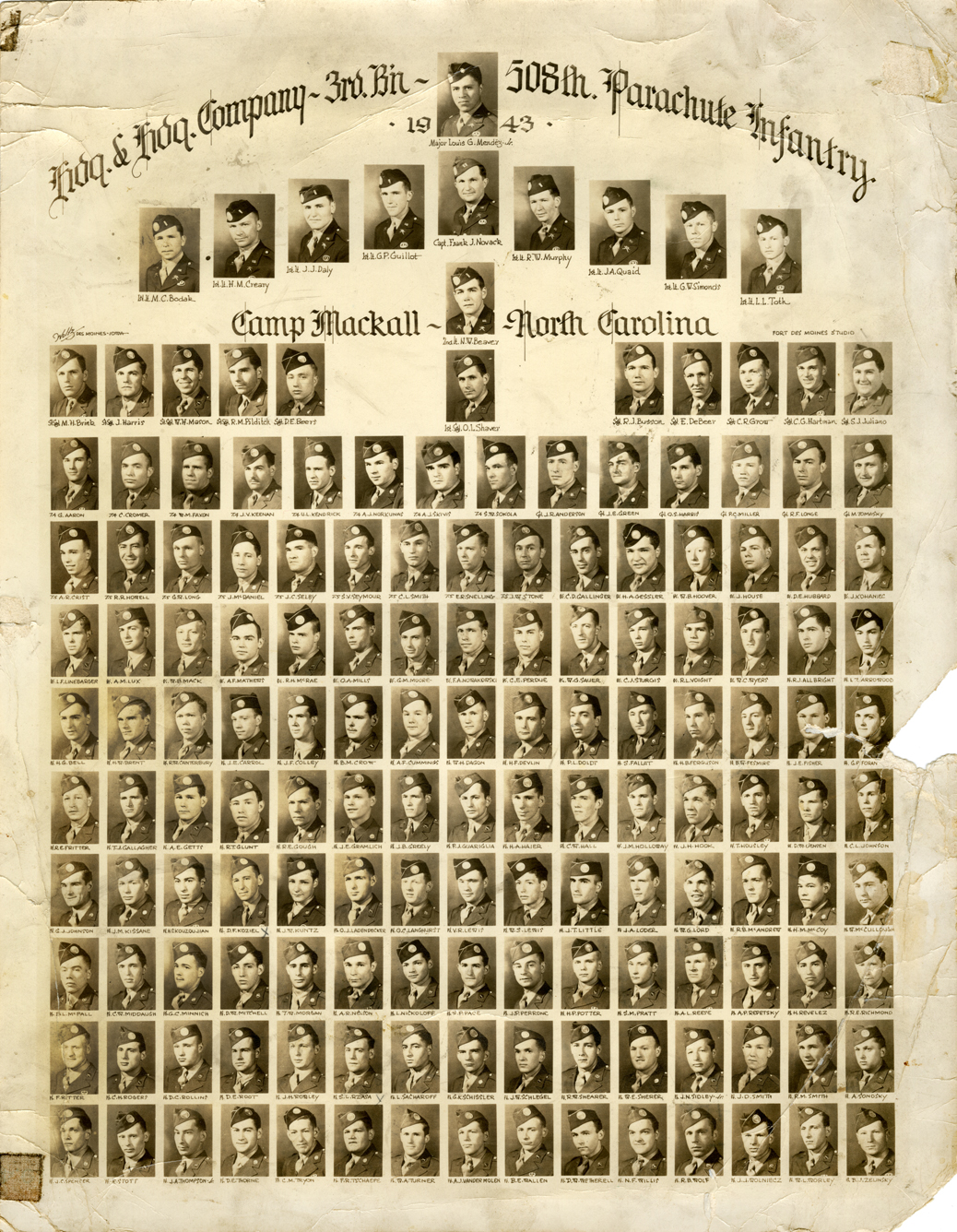
Daily Report from HQ 3rd BN, 508 PIR noting Steven Rzasa being
seriously injured on 6 June and moved to an unknown field hospital (Daily
Reports courtesy of
Richard J. O’Donnell
Webmaster & National Chairman,
Family & Friends of the 508th PIR Association).
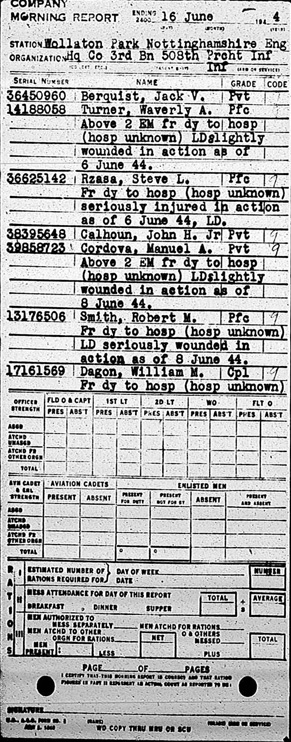
The first telegram announcing Steven Rzasa's wounding on D-Day.
Daily Report from HQ 3rd BN, 508 PIR noting Steven Rzasa being returned to duty at 10 am on 11 June, 1944. This happened in Montessy, France, left side of hill 300 enroute to Taillefer, France.
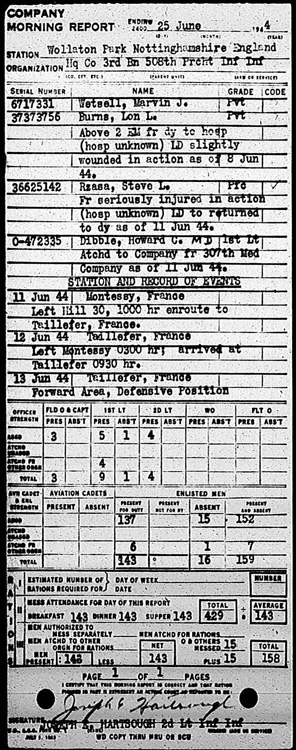
The letter announcing his return to duty. By the time this letter was written, he was dead.
Daily Report from HQ 3rd BN, 508 PIR noting Steven Rzasa being killed inaction on 20 June, 1944.
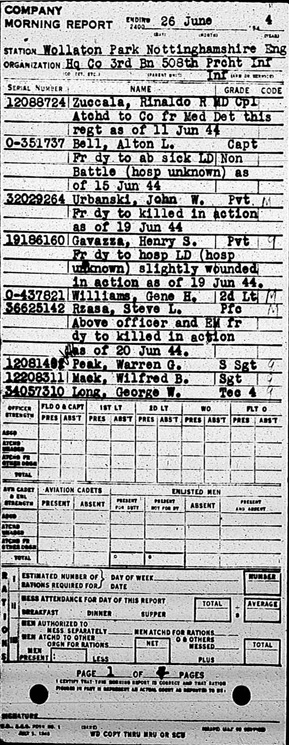
Telegraph # 2 announcing Steven's death on 20 June 1944.
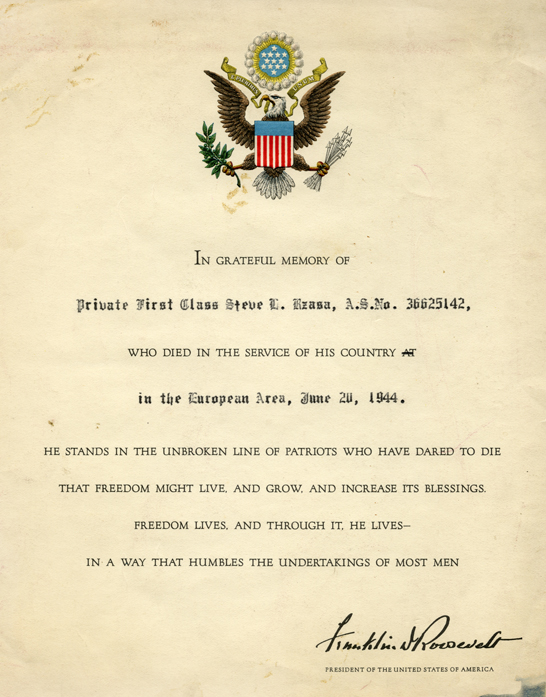
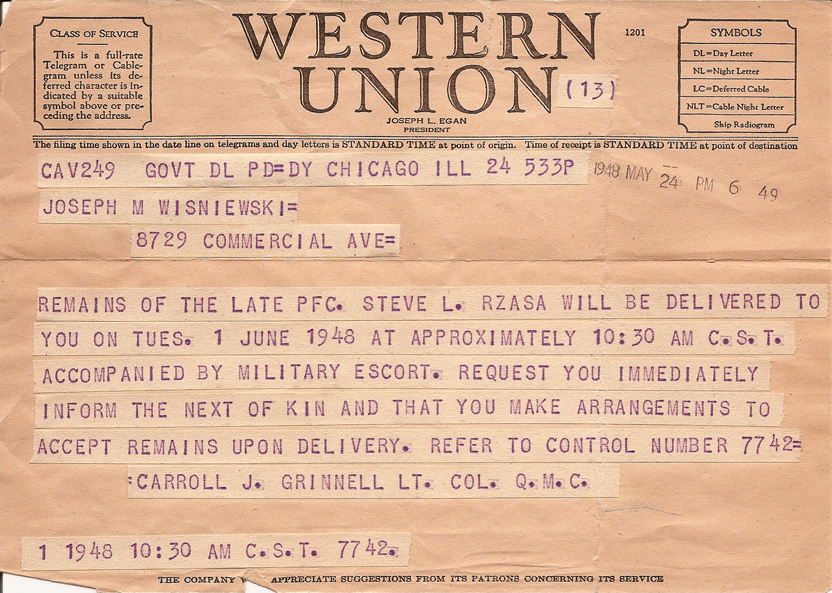
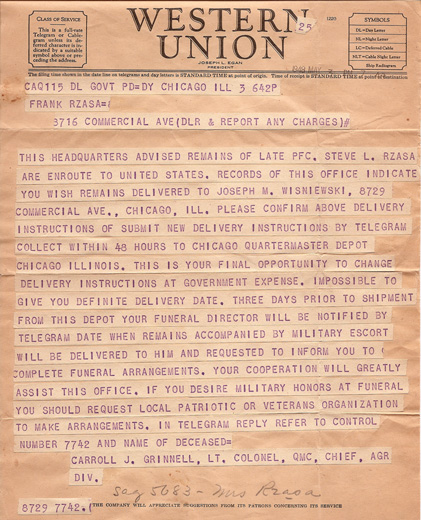
Steven's mom, Mary Fugiel Rzasa, as a Gold Star Mother.
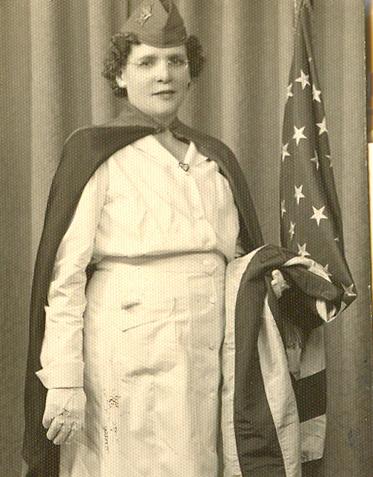
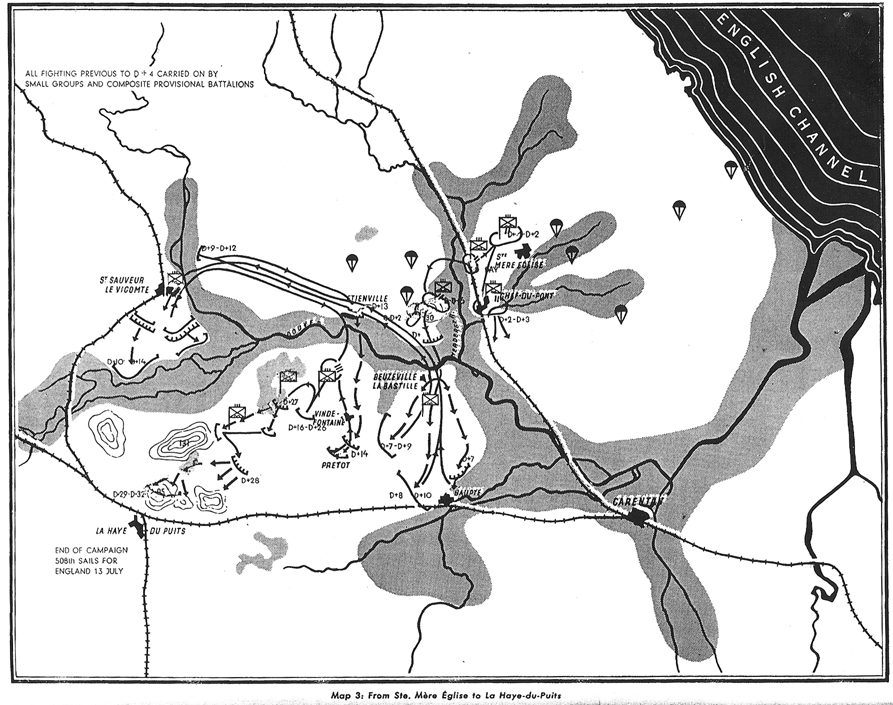
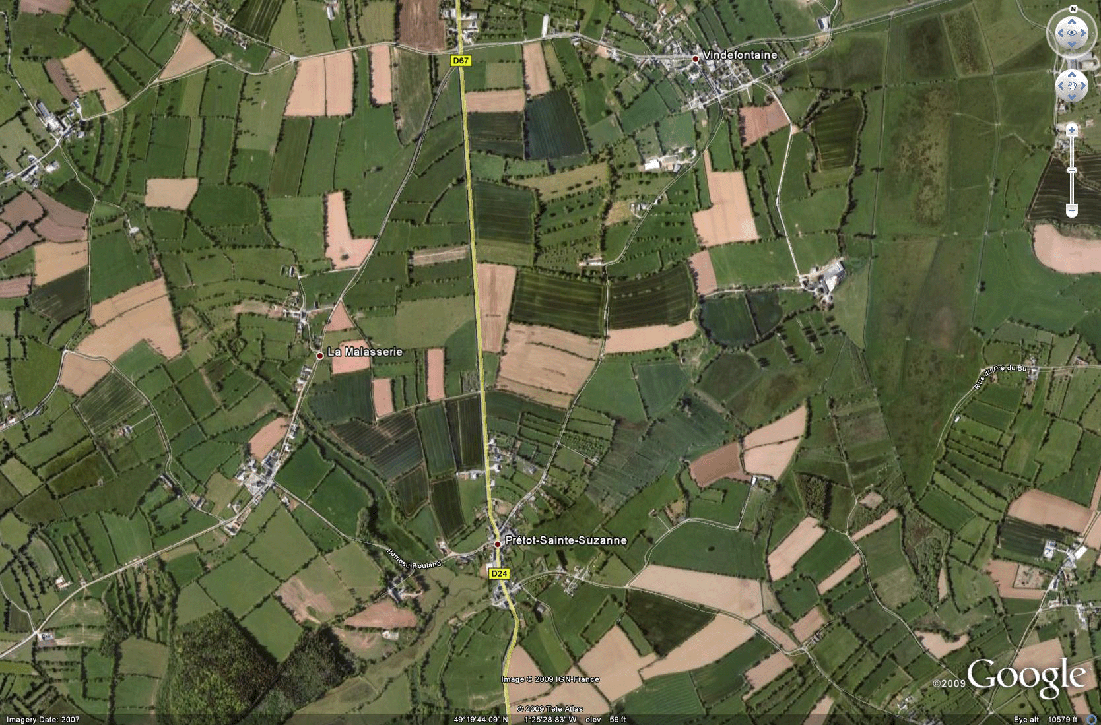
Close up of Pretot today from Google Earth.
From History of the 508th Parachute Infantry by William G. Lord, II, Washington, Infantry Journal Press, 1948.
"At dawn on the 20th the [3rd] battalion attacked toward Pretot to protect the left flank of the 325th Glider Infantry. Met by accurate small-arms, artillery, and mortar fire the leading elements of the battalion were soon halted. Realizing that to remain in the open could only mean suicide, Colonel Mendez worked his way to the front of his command, stood up, and personally led his men on their first major offensive against a well organized enemy.
... It soon became apparent that the positions in Pretot were untenable. A German tank on the outskirts of town badly shot up what was left of Lieutenant Robert M. Mitchell's platoon. Artillery, apparently coming from all directions, took an extremely heavy toll.
In the early afternoon, the battalion commander issued the order to withdraw to the high ground 600 yards north of Pretot. Later in the evening the 507th Parachute Infantry relieved the Red Devils and they moved back to a reserve area on the south bank of the Douve. Here they met the rest of the regiment which, after the 90th Division had passed through, had moved there by truck from the St. Sauveur area " (p 31).
Since this was Steven Rzasa's battalion and June 20th was the day of his death, it can be assumed that this battle was where he was killed.
Some History of the 3rd Battalion, 508 PIR from their Association Website:
Excerpts from the previously classified AAR
RECORD OF
PARTICIPATION OF 508TH PARACHUTE INFANTRY IN
NORMANDY OPERATIONS
From 6 June to 15 July, 1944
THE 508TH PARACHUTE INFANTRY, attached to the 82d Airborne Division, landed in
Normandy, France, as part of that division on D Day, 6 June 1944, between the
hours of 0208 and 0220. Although it was planned to drop the regiment in one drop
zone north of PIQUAVILLE in four serials, the organization was widely scattered,
the majority landing east of the original drop zone and as-
tride the MERDERET RIVER, and some personnel landing nine kilometers south of
CHERBOURG. (For drop pattern see Overlay No. 1 )As the plane formation struck
landfall it became engulfed in a heavy cloud bank, causing many planes to lose
formation. The air column encountered heavy flak concentration and AA - MG fire;
one plane is known to have crashed with all personnel aboard.
Some casualties were suffered when men were hit in the planes. Subsequently a
few men were hit during the parachute descent.
Fairly heavy small arms fire on the ground made a proper reorganization impossible. Little or no equipment was recovered from the equipment containers due to resistance on the drop and because much of the equipment had landed in the MERDERET and DOUVE RIVERS. The regiment was divided into many small groups, each of which began "-o fight its way individually to its objective, leaving dead Germans, wrecked German vehicles and disrupted communications behind it; Company "G" was dropped intact and reorganized completely with all personnel and equipment in the vicinity of STE MERE EGLISE. There was very little resistance on the ground in this area to interfere with a prompt reorganization.
The regiment assembled in four distinct groups-- Group L, commanded by Colonel Lindquist, Group W, commanded by Major Warren; Group S, commanded by Lt. Colonel Shanley; and Group G, consisting of a combined force of Company G, under command of Captain Novak plus a small group of approximately twenty-five men under command of Captain Simonds. Each group was a composite unit consisting of parachutists from 508th, 507th, and 505th, and members of the 101st A/B Division, the majority being members of this regiment.
6 June - (D Day )
Group L assembled in the vicinity of La FIERE, fought its way south along the railroad to the highway across the railroad two and one-half kilometers west of STE MERE EGLISE and then turned southwest along highway for the purpose of crossing the MERDERET RIVER and moving to the area north and northwest of ETIENVILLE ( FONT L'ABBE ) to contact elements of the 508th Parachute Infantry and to carry out the mission assigned by the 82d A/B Division. This group encountered and attacked a German strongpoint defending the bridge across the MERDERET, four kilometers west of STE MERE EGLISE. At this point Colonel Lindquist made contact with Force A, Headquarters 82d A/B Division. On the afternoon of D Day Group L with some assistance from a company of the 505th Parachute Infantry (whose original mission was to seize the bridge), wiped out the German unit in that locality. That evening Group L was relieved by 1st Battalion, 505th Parachute Infantry and organized a defensive position around the railroad viaduct on the same road a few thousand yards to the east.
Group W, about: 2.00
strong, organized south of DZ and fought its way north to a point 500 yards east
of PICAUVILLE. This group then seized a position on the high ground south of
GUEUTTEVILLE, occupying the area previously designated for the Force A reserve (
1st Bn ). During the afternoon of D Day Group W fought off the combined attack
of a large German force reinforced with tanks and SP guns. Able only to contact
Group S, Major Warren broke off the action at about 1900 and joined Group S
about 1000
yards east of PICAUVILLE. Group S originally consisted of about a platoon, which
fought a battalion of Germans reinforced with 4 tanks and a battery of light
artillery during the whole morning of D Day, just north of PICAUVILLE. About
noon Group S broke off the action and moved east, picking up about 150 officers
and men, and occupying a defensive position east of PICAUVILLE where it was
joined by Group W. The group consisted of about 400 officers and
men from various organizations, with only three LMGs, one BAR, one 60 mm mortar
Cube, and no other heavy weapons. On D night Group S moved under cover of
darkness in two columns abreast to Hill 30, which is just west of the MERDERET
and south of GUEUTTEVILLE, and organized the hill for all around defense.
Group G secured the east end of the causeway across the MERDERET at CHEF DU FONT and occupied a position defending the bridge there, after routing about a company of Germans who had been defending the town and the bridge from well dug defensive positions.
Page 4
13 June
The 3rd Battalion crossed the DOUVE at 0430 followed by Regimental Headquarters Company, moved down the center of the regimental area in a column of companies, and occupied an all around defensive position at TAILLERFER in the corridor between FONT AUNY and HOTOT. Regimental CP was established at 0700 at TAILLERFER.
Page 5
14 June 1944
1st Battalion arrived at 0130 from COIGNY to join 2nd Battalion at BAUPTE and assist in defense of the town. The battalion arrived at BAUPTE and established a perimeter defense west of the town at 0700.
At 0700 3rd Battalion was attacked by a small force with with small arms fire. By 0735 the 3rd Battalion had repelled this attack causing many casualties among the enemy, estimated at one company. At 1005 the 3rd Battalion notified regiment that a large force of enemy was concentrating in the area one kilometer northeast of LES SABLONS. At this time a 15 minute artillery concentration was called for to start at 1030.
Page 7.
17-19 June 1944
The 3rd Battalion, under Division control, crossed the DOUVE from a location west of ETIENVILLE in assault boats commencing at 0500. The battalion established a bridgehead on the south bank of the DOUVE and quickly organized a defensive position. At this time the battalion was attached to the 325th Infantry and given the mission of seizing and holding PRETOT. The Battalion moved in a column of companies, passing through VINDE FONTAINE, met an enemy strongpoint 900 yards south of VINDE FONTAINE and bypassed It to the east. The Battalion then moved into an attack assembly area 600 yards north of PRETOT, under persistent sniper and machine gun fire. During the evening a Mark IV tank was knocked out by a soldier from Company I with a hand thrown rifle grenade.
Page 8
20 June 1944
At 0430 the 3rd
Battalion moved to its line of departure astride the stream following from the
northeast into PRETOT, and launched an attack from the northeast into PRETOT at
0600. After a fifteen minute preparation by artillery the battalion attacked
fast under cover ,of heavy and accurate supporting fire. The remnants of the
Germans defending the town fled south in disorder, and the battalion established
a defensive position at PRETOT. The
enemy had observation from high ground south and east of PRETOT. The enemy had
observation from high ground south and east of PRETOT, and subjected the
battalion Co heavy artillery and mortar shelling. At 1600 the battalion was
ordered by division to move from the town of PRETOT to a position on high ground
just west of the town. The Battalion was relieved by the 1st Battalion, 507th
Parachute Infantry at 2330.
The Aircraft and Chalk Number of Steven Rzasa
June 5, 1944 Operation Neptune
508th Hq
3rd Roster Aircraft
43-15345
- Chalk
54
Aircraft Manifest (page 2) for Aircraft designation 315345.
The fate is not known for all these men but some are listed on the Roll of
Honor while others are documented as having received the Purple Heart and may
have been evacuated but a few are known to have survived the war. The entire
stick roster appears below: Entries within parentheses are correct spellings
rather than what appeared on the roster.
(Courtesy
Brian Siddall)
|
Name and Rank |
Unit |
Fate |
|
Sgt Zelinsky, Bernard J |
Hq/3 |
KIA 5 Jul 44 |
|
Pvt. Lantom (Leston), Francis J |
Co D |
? |
|
Cpl Loder James A |
Hq/3 |
Died Dec 1, 2005 |
|
Pfc Saver, Wilbur A (Sauer, Wilbur G.) |
Hq/3 |
Apr 1990 |
|
Pvt Perdue, Clyde E (Jr.) |
Hq/3 |
Died Apr 4, 1990, OH |
|
Pvt Tachange (Tschaepe), Frank R (Jr.) |
Hq/3 |
Died Jul 3, 1988, NY |
|
Pvt Morgan, Thomas W |
Hq/3 |
Oct 2000 |
|
Pvt Peters, Gorrell |
Hq/3 |
Died Oct 1, 2001 |
|
Pvt Bromley, Arthur L |
Hq/3 |
Died Sep 7 1993, MO |
|
Pfc Thomas, Dewey E |
? |
Died Jun 11, 2004 |
|
Pfc Walniendes, John J |
? |
? |
|
Pvt Rzaza (Rzasa), Steve L |
Hq/3 |
KIA 2 Jul 44 |
|
Barnhart, Ray L |
Hq/3 |
Died Feb 4, 2000 |
|
Pvt Bailey, Edward N |
Hq/3 |
Died Dec 7, 1988, GA |
|
Pvt Knox, Kenneth C |
Hq/3 |
Jan 2001 |
|
Cpl Mills, Okey |
Hq/3 |
Died Jan 5, 2001, WV |
|
There are conflicting reports regarding the fate of this C-47, serial number 43-15345. According to the November 1950 USAF Accident Reports the aircraft was in service with the 2230th AF Reserve Training Center and destroyed while parked at Naval Air Station Floyd Bennett, (Brooklyn), NY. This C-47A was apparently struck by a C47A #42-101000 piloted by Ver Nooy, Russell A. (rank not stated). However, a report filed by the Aviation Safety Center states that the aircraft was still in service with the U.S. Air Force when it crashed at Elmendorf AFB, Alaska on 09 Sep 1958 following engine problems that developed during take-off. Thirteen of its 20 occupants were killed and the aircraft was written off as damaged beyond repair. Finding two such disparate reports on the aircraft is highly unusual. It is possible that the year of manufacture was misstated in one case or the other. |
||
Page 12
TABULATION
|
Committed Strength Killed in Action Wounded in Action Missing in Action Strength on 15 July *Germans Captured *Vehicles Captured *Tanks Destroyed
*Field Pieces (75mm or
*Ground Gained (This
figure takes into account only the gains made by forward elements of the
regiment with no friendly troops to the front)
*Minimum figures |
2,055 321 660 58 918 554 75 20 8
|